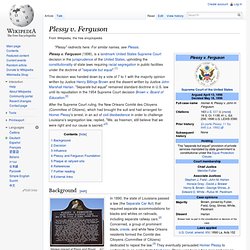

The Rise and Fall of Jim Crow . Jim Crow Stories . Plessy v. Ferguson. Plessy v. Ferguson (1896) The ruling in this Supreme Court case upheld a Louisiana state law that allowed for "equal but separate accommodations for the white and colored races.

" During the era of Reconstruction, black Americans’ political rights were affirmed by three constitutional amendments and numerous laws passed by Congress. Racial discrimination was attacked on a particularly broad front by the Civil Rights Act of 1875. This legislation made it a crime for an individual to deny “the full and equal enjoyment of any of the accommodations, advantages, facilities, and privileges of inns, public conveyances on land or water, theaters and other places of public amusement; subject only to the conditions and limitations established by law, and applicable alike to citizens of every race and color.”
In 1883, the Supreme Court struck down the 1875 act, ruling that the 14th Amendment did not give Congress authority to prevent discrimination by private individuals. Tre's Notes. After the Civil War: Plessy v. Ferguson. Audrey's Notes. The Rise and Fall of Jim Crow . Jim Crow Stories . Plessy v. Ferguson. Notes. Plessy v. Ferguson. Plessy v.

Ferguson (1896), is a landmark United States Supreme Court decision in the jurisprudence of the United States, upholding the constitutionality of state laws requiring racial segregation in public facilities under the doctrine of "separate but equal".[1] The decision was handed down by a vote of 7 to 1 with the majority opinion written by Justice Henry Billings Brown and the dissent written by Justice John Marshall Harlan. "Separate but equal" remained standard doctrine in U.S. law until its repudiation in the 1954 Supreme Court decision Brown v.
Tre's Notes. Plessy v. Ferguson. Audrey's Notes.